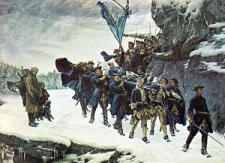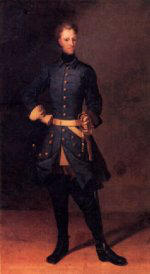

Copyright © Hans Högman 2017-10-27
The Many Swedish
Wars - 1700s
A Summary of the Great Northern
War 1700 - 1721
The Great Northern War - Introduction
Map, the Swedish borders before the war
When King Karl XI of Sweden died in 1697 he had
introduced the New Allotment System (Det yngre
indelningsverket) and rearmed the Swedish armed
forces. The soldiers were well trained and well
equipped. The Swedish Army was at this time
probably the best army in Europe.
When the 15-year-old Karl XII became the new
sovereign of Sweden he was in command of a
perfect military machine.
In Russia, Peter the Great was the
new tsar. In Poland, August, Elector
of Saxony, had been elected new
king of Poland and in Denmark
Frederik IV had been crowned as a
new king.
Karl XII, Frederik IV and August II was
by the way, cousins.
The picture to the right shows King
Karl XII of Sweden.
Pact of aggression against Sweden
Russia, Poland and Denmark formed a pact of
aggression against Sweden. They were all after
Swedish territory. Russia was after the Baltic coast,
Poland wanted Livland (a Swedish Baltic province)
and Denmark wanted to regain the Skåne provinces
in south of Sweden.
So, in August 1698 Peter the Great and August of
Saxony made plans of a pact of aggression against
Sweden. In July 1699 Denmark and Russia signed the
pact and in September 1699 Denmark and Poland.
Finally, in November 1699, Russia and Poland signed
the pact of aggression.
At this time Sweden had an alliance with England
and the Netherlands.
The tension between Sweden and Denmark
increased in 1697 when Danish forces destroyed
fortifications in Holstein-Gottorp, Northern
Germany.
Holstein-Gottorp was an allied of Sweden and
Sweden sent a force of 2,400 soldiers from Wismar
and Bremen, two Swedish provinces in northern
Germany, to rebuild the fortifications.
Strengthened by the pact of aggression, Denmark
started to be more and more aggressive towards
Holstein-Gottorp.
In February 1700, August of Saxony attacked
Swedish Livland with troops from Saxony. In March
1700, when Frederik IV got information on this, he
launched an attack on Holstein-Gottorp.
Sweden answered by sending a force of 17,000
soldiers to Holstein-Gottorp, 7,000 Swedes and
10,000 soldiers from Lüneburg.
Karl XII decided to deal with Denmark before he
turned on August of Saxony/Poland.
The War with Denmark
In June 1700 the Swedish Navy set sail. Together
with navy units from England and Netherlands, the
Danish Navy was forced to stay in port.
Sweden, Lüneburg, England and the Netherlands
were there to guarantee the independence of
Holstein-Gottorp.
On July 25, 1700, Sweden landed a force at
Humlebäck, Denmark, just north of Copenhagen
on Zealand. The landing area was soon in Swedish
hands and the force was extended to 10,000
soldiers.
Karl XII planned to attack Copenhagen but King
Frederik IV of Denmark immediately initiated peace
talks. Denmark was forced to peace and the peace
treaty was signed in Traventhal on August 18,
1700.
Karl XII wanted to attack Copenhagen before any
peace talks, however both England and the
Netherlands were against that.
In the peace treaty Denmark was forced to leave the
pact of aggression against Sweden.
See detailed map plus a map of Skåne/Zealand.
August of Saxony/Poland had to use soldiers from
Saxony when he attacked Livland since the Polish
parliament didn’t allow him to use Polish soldiers in
the war. The Polish parliament believed the war with
Sweden was a personal war for August.
In May 1700, a Swedish relief force arrived to
Livland from Finland with 3,200 soldiers. This force
had no problem to drive the soldiers of August out
of Livland.
During the summer of 1700, August returned to
Livland with an army of 18,000 men and occupied
the Swedish province and besieged the city Riga.
The War with Russia and the Battle of Narva
on November 20, 1700
In September 1700, Karl XII received information
that also Russia had broken the peace and had
made an attack on Swedish Finland and
Ingermanland. In October the city of Narva in
Estonia was besieged by an Russian force of
30,000 – 35,000 men. The Swedish garrison at Narva
still held the fortress and the city.
With this fact in hand, King Karl XII of Sweden decided
to deal with Russia before August of Saxony/Poland. A
Swedish force of 8,000 soldiers was shipped to
Pernau in the Baltic region (present day Estonia). The
force was there extended to 11,000 soldiers. Instead
of waiting for reinforcements, Karl XII immediately
started the march towards Narva. On November 20
1700, the Swedish force of 11,000 soldiers
attacked the Russian army in Narva of more then
30,000 Russian soldiers in the battle of Narva.
Despite the disadvantage of being outnumbered by
the Russians, the Swedes won a splendid victory.
After the battle the Swedes camped for the winter at
Dorpat. During the winter the Swedish field army in
the Baltic was extended to 18,000 men.
King Karl XII now had to decide whether to go
directly to Moscow or to go south and first deal with
August II. Karl XII decided for August and Poland.
The War with Poland and Saxony
On July 9, 1701 the Swedes crossed the Düna river.
On the south side of the river August and his 20,000
strong army waited. Also this battle was a splendid
Swedish victory. After the battle the Swedes
occupied the whole of Kurland and the road to
Warsaw was now fully open.
The following years included many campaigns in
Poland. The purpose of Karl XII was to force the
Polish to remove August from the throne of Poland
and the Swedish king succeeded in doing so.
Since Poland now was under attack by the Swedes,
August got permission to use the Polish army in the
war. The Swedes began occupying Poland in 1702
and in May, Warsaw was in Swedish hands. The
Polish were reluctant to remove August from the
throne, which resulted in many years of war. In the
beginning of 1704, Poland gave up and August was
removed from the throne. On July 2, 1704 the
Swedish candidate Stanislav Leczinski was elected
new King of Poland and on September 24, 1705 he
was officially crowned.
The Swedes were thereby satisfied and prepared to
sign a peace treaty with Poland. The treaty was
signed on November 17, 1705 in Warsaw.
See detailed map.
Saxony:
However the chase for August wasn’t over. On
February 3, 1706 the Swedish army defeated an
army from Saxony at the Battle of Fraustadt.
During the summer of 1706, Karl XII decided to cross
the border to Saxony to force August to give up all
plans of the Polish throne. This had effect and
August surrendered. A peace treaty between
Sweden and Saxony was signed on September 14,
1706 in Altranstädt.
In the peace treaty August was forced to give up all
plans of the Polish throne and agreed not to
participate in any wars against Sweden. The Swedes
didn’t leave Saxony until 1707.
See detailed map.
The War with Russia
Se detailed map.
Now it was time to deal with Russia, the last of the
enemies in the pact of aggression. The Swedish
march eastwards begun during the fall of 1707.
At this time the Swedish field army in Poland
counted 35,000 soldiers. About 24,000 of them were
horsemen. Roughly 11,000 soldiers were left in
Poland for protection of king Stanislav.
One way of dealing with the Russians would have
been to return to the Swedish provinces in the Baltic
and remove the Russians from those areas and then
turn to Moscow. However, Karl XII decided to directly
go for Moscow.
1708
During 1708 the march to Moscow continued. On
June 30 1708 the Swedish army met up with the
Russian main army in the Battle of Holowczyn.
Although only a part of the Swedish army had
arrived at Holowczyn, Karl XII decided to attack. The
battle ended with a Swedish victory. The Swedish
cavalry carried out a splendid battle and had a lot to
do with the victory.
After this battle the Russians avoided any further
battles and withdrew as soon as the Swedes
approached them. However, the Russians constantly
irritated the Swedish army by small-scale attacks and
ambushes. As the Russians retreated, they burnt all
villages and fields to make it more difficult for the
Swedes to obtain supplies etc.
During the summer of 1708, the Swedish general Adam
Ludvig Lewenhaupt, governor of Livland, received orders
to pick 11,000 men from the Swedish force in Livland
and join the Swedish field army.
During the march to Karl XII and the field army, the
Russians attacked the Lewenhaupt force on
September 29, 1708 in Ljesnaja. The attack was a
ambush and a very bloody battle with a lot of
casualties on both sides. After a 4th attack the
Swedes had to withdraw. However all the artillery
and the supplies had to be left behind, supplies that
was badly needed by the filed army.
At the end of August 1708, King Karl XII decided to
change the route and go south to Ukraine to get in
contact with Ivan Mazepa and his Cossacks and to
get him join the Swedes in the war against Russia.
During the very cold winter of 1708/09 the Swedes
went into winter camp in the northern parts of
Ukraine. The supply situation was very bad for the
Swedes.
1709
In April 1709 the Swedes besieged the city of
Poltava. In the fortress of the city there was a
Russian garrison.
The Swedish field army didn’t count more then
25,000 soldiers at this point. In the middle of June
King Karl XII had a gun wound when he was hit at
the foot by a Russian sniper.
At the end of June a Russian army of 40,000 soldiers
was arriving at the scene.
On June 28, 1709, the Swedish army attacked the
camp of the Russian army just north of Poltava. The
Swedish army had been outnumbered in lots of
battles, so being outnumbered this time didn’t
bother them. The Battle of Poltava turned out to be
a very bloody battle. In reality it was two battles on
the very same day. Due to Karl XII:s wound, the
command of the army was handed over to General
Carl Gustav Rehnskiöld.
The so victorious Swedish army was finally defeated
at Poltava. Circa 6,900 Swedish soldiers were killed in
the battle. About 2,760 soldiers were taken prisoner
of war. In total 9.600 soldiers were lost for the
Swedish army in the battle.
The Russians lost 1.345 in dead soldiers and 3,290
were wounded.
The Swedish losses in the battle were tremendous.
The Swedish cavalry was more or less intact; it was
the infantry that had the greatest losses.
Poltava on the map.
After the battle the Swedish army retired to
Perovolotjno. This was next to the Dneper river.
During the night to July 1, King Karl and a few
thousand soldiers crossed the river and headed for
Bender in Turkey. At Perovolotjno, general
Lewenhaupt was in charge of the remaining Swedish
field army. During the day of July 1, 1709, parts of
the Russian army approached Perovolotjno. Against
given order, general Lewenhaupt surrenders to the
Russians. About 16,000 Swedish soldiers were taken
prisoners of war. A whole army ceased to exist. This
was a tremendous blow to Sweden.
The Swedish defeat at Poltava had far-reaching
consequences for Sweden. Both Denmark and
August of Saxony/Poland now saw a chance when
the Swedes had been defeated at Poltava.
On August 8, 1709 Denmark once again declared
war on Sweden. Also in August, August of Saxony
crossed the Polish border with his army. Once in
Poland he was accepted as new King of Poland and
declared war on Sweden.
In November, the Danes landed a force of 14,000
soldiers in Skåne. In Sweden a new army was raised
and General Stenbock takes on the Danes in Skåne.
On February 28, 1710 the Swedes defeated the
Danish army in Skåne at the Battle of Helsingborg.
After the battle the Danes evacuated their forces in
Skåne. Instead the Danes concentrated on the
Swedish provinces in northern Germany.
See detailed map.
1712
In 1712 Stenbock shipped his army to Germany to
liberate the occupied Swedish possessions there. On
December 9, 1712 Stenbock defeated a combined
army of soldiers from Denmark and Saxony in the
Battle of Gadebuch. After the battle the Swedes
moved north to the fortress at Tönningen in
Holstein-Gottorp. The enemy besieged the fortress
and due to hunger and diseases the Swedes had to
surrender on May 5, 1713.
This was the second Swedish army during a short
period that was lost for the Swedes. Once again new
regiments had to be recruited.
In 1710, the last of the Swedish possessions the
Baltic; Viborg, Riga, Reval and Pernau, were lost to
the Russians. During 1713, the Russians attacked
Finland and in 1714 Finland was in the hands of the
Russians.
1715
In June 1715, Prussia declared war on Sweden,
attacked Pommern and besieged Stralsund. The
attacking Prussian army counted 50,000 soldiers.
King Karl XII had at this time left Bender and was
now in Stralsund. However, the King left Stralsund
just in time before the city capitulated.
In October 1715, also Hanover declared war on
Sweden.
See detailed map.
Back in Sweden, Karl XII planned for counter-moves.
One move was to attack the Danish Norway. The
attack on Norway was launched on February 18,
1716. The attack was difficult due to very bad
snowstorms and in April the campaign was
terminated.
During 1716, the last of the Swedish possessions in
Northern Germany falls into the hands of the
enemy.
1718
During 1717 Karl XII planned for another attack on
Norway. One of the purposes of the attack was the
get a hold on Denmark in the coming peace
negotiations.
In August 1718 the attack was launched on two
fronts. One attack went from the Swedish provinces
Värmland/Dalsland into Norway and one went from
Jämtland into the Trondheim County in Norway.
General Carl Gustav Armfeldt was in charge of the
northern attack, the one from Jämtland.
King Karl XII was killed in action on November 30,
1718 at the Fredrikshald fortress and the whole
Norwegian campaign was terminated.
The northern retreat from Trondheim County was
done over the mountains between Norway and
Sweden during the New Year Eve / New Years Day
1718/1719 in a very cold and heavy snowstorm. A
very large number of
soldiers froze to death on
the mountains that night.
The picture to the right is
Gustav Cederström's
painting from 1878: The
Last Journey of King Karl
XII of Sweden.
After the death of King Karl XII, his sister Ulrika
Eleonora was elected on February 23, 1719 new
sovereign of Sweden as Queen Ulrika Eleonora.
The plan of Sweden was now to get peace with all its
enemies, except the Russians. Then the idea was to
get an alliance with England in order to get better
terms in the peace negotiations with Russia.
Also Russia is looking for peace, but since the
Swedes was delaying the peace talks, Russia sent
their galley fleet to Sweden to ravage the Swedish
coast. This was done to set pressure on Sweden and
get the Swedes willing to peace talks. The Russians
burned many coast towns.
On August 13, 1719 at Södra Stäket, just south of
Stockholm, the Swedish Södermanland Regiment
stopped a Russian landing attack.
The Danish fleet operated on the Swedish west
coast. With diplomacy, England forced Denmark to
stop their operation on Swedish waters.
On October 28, 1719 Sweden signed an armistice
with Denmark for 6 months.
On November 9, 1719 a peace treaty was signed
in Stockholm between Sweden and Hanover. In
the treaty, Sweden had to give up the provinces
Bremen and Verden in northern Germany. See
detailed map.
On February 29, 1720 the Swedish Queen Ulrika
Eleonora abdicated in benefit of her husband,
Fredrik av Hessen. As a new king he received the
name King Fredrik I.
On January 21, 1720 a peace treaty was signed in
Stockholm between Sweden and Prussia. In the
treaty, Sweden had to give up an area in southern
Pommern, more exactly, the land south of river
Peene and east of river Oder plus the islands
Usedom and Wollin. See detailed map plus map of
Pommern.
On June 3, 1720 in Stockholm, Sweden finally
signed a peace treaty with Denmark.
According to the treaty, Sweden had to give up the
exemption from duty at the sound between Sweden
and Denmark. Sweden also had to pay a 600,000
riksdaler to Denmark.
The peace treaty was a disappointment to Denmark
who had hoped to regain the Skåne provinces from
Sweden. However, England was an allied of Sweden
and forced Denmark to accept the terms.
Also during the summer of 1720 Russian galleys
were ravaging the Swedish coast. On July 27, 1720
the Swedish navy came a cross a Russian galley fleet
at the Åland islands between Finland and Sweden.
The Russian galleys were badly damaged in the
battle and had to retreat to Russia.
The Swedish and Finnish coastlines are filled with
thousands and thousands of islands. In most cases
these waters between the islands are narrow and
very shallow. The big navy ships of the line were too
big and too deep draught to pursue the galleys into
shallow waters through the narrow channels of the
archipelago of Swedish waters. However, Galleys
couldn’t engage large navy ships in battle on the
open sea. But, with hardly any wind in coastal waters
galleys could attack a navy ship and win the battle if
they attacked from behind.
During 1720 England sent a navy fleet to the
disposal of the Swedes. This strengthening of the
Swedish fleet was to remain for the rest of the war.
On August 30, 1721, a peace treaty finally was
signed in Nystad between Sweden and Russia.
The treaty ended the Great Northern War.
In the peace treaty Sweden had to give up all
possessions in the Baltic; Ingermanland, Livland and
Estonia including the islands Ösel and Dagö. Further,
Sweden lost Viborg County and the southern part of
Kexholm County, both in the southeastern part of
Finland.
See detailed map
There were no formal peace treaties between
Sweden and Poland / Saxony. However, on April 28,
1729 the war formally ended with Saxony when
Sweden and Saxony signed a declaration of
friendship. A similar declaration was signed with
Poland on September 26, 1732.
Top of page















